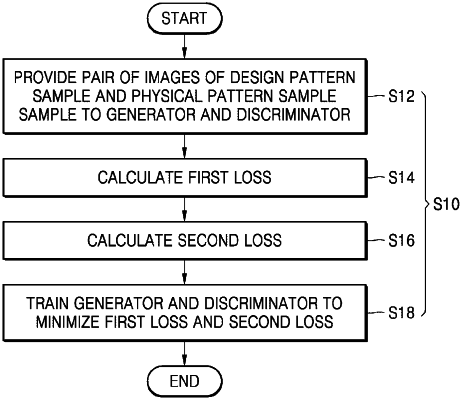| CPC G06F 30/27 (2020.01) [G06N 3/045 (2023.01); G06N 3/08 (2013.01); G06F 2119/02 (2020.01); G06F 2119/18 (2020.01)] | 14 Claims |

|
1. A system for modeling a semiconductor fabrication process, the system comprising:
at least one first processor configured to provide at least one machine learning model, the at least one machine learning model being trained by using a plurality of pairs of images of a design pattern sample and a physical pattern sample, the physical pattern sample being formed from the design pattern sample by using the semiconductor fabrication process; and
at least one second processor configured to provide an input image representing a shape of a design pattern and/or a physical pattern to the at least one first processor and to generate output data defining the physical pattern and/or the design pattern based on an output image received from the at least one first processor,
wherein the at least one machine learning model comprises a generative adversarial network comprising a generator and a discriminator, which are trained by using the plurality of pairs of images,
wherein the at least one second processor is configured to provide the input image to the generator and to generate the output data based on an output image received from the generator,
wherein the at least one second processor is configured to train the machine learning model based on a pair of images of a first design pattern sample and a first physical pattern sample, which correspond to each other, by calculating a first loss based on an error between an image of the first physical pattern sample and a first output image of the generator, wherein the first output image corresponds to the first design pattern sample,
calculating a second loss between a first output of the discriminator and a second output of the discriminator, wherein the first output of the discriminator corresponds to the first physical pattern sample, and the second output of the discriminator corresponds to the first output image, and
training the generator and the discriminator to reduce a sum of the first loss and the second loss.
|